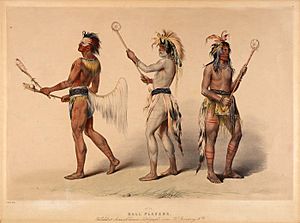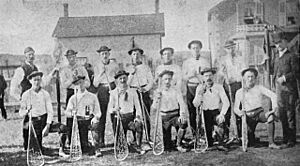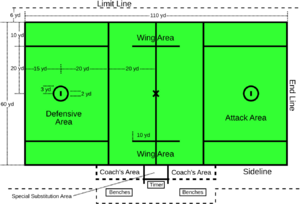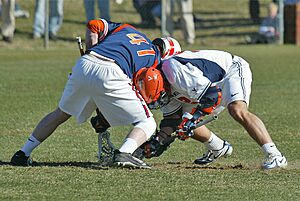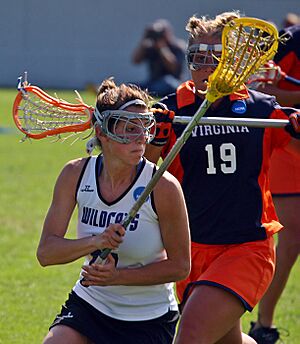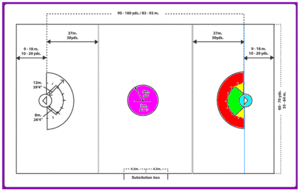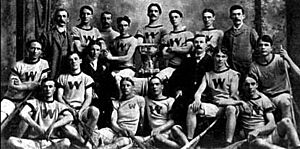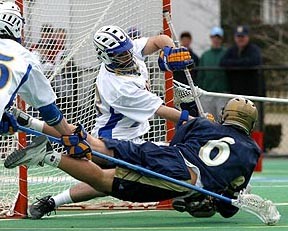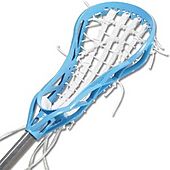Lacrosse facts for kids
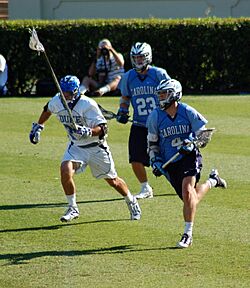
Men's field lacrosse game between North Carolina and Duke
|
|
| Highest governing body | World Lacrosse |
|---|---|
| Nicknames |
|
| First played | 12th century, modified by Europeans in the 17th century |
| Characteristics | |
| Contact | Yes |
| Type | Team sport, stick sport, ball sport |
| Equipment | Lacrosse stick and ball in addition to various body armor or pads. Different protective gear for different versions of the game |
| Venue | Outdoor lacrosse field or indoor lacrosse rink |
| Presence | |
| Olympic | Men's field at the Summer Olympics in 1904 and 1908. Demonstrated in 1928, 1932 and 1948 Men's and women's sixes in 2028 |
| World Games | Women's field in 2017 Men's and women's sixes in 2022 |
Lacrosse is a fast-paced team sport where players use a special stick to catch, carry, and throw a ball. It's the oldest organized sport in North America, first played by Native Americans as far back as the 1100s! Later, European settlers changed the game, leading to the modern sport we see today.
Players use the net at the end of their lacrosse stick to scoop up, pass, catch, and shoot the ball into a goal. There are five main types of lacrosse, each with different sticks, fields, rules, and gear: field lacrosse, women's lacrosse, box lacrosse, lacrosse sixes, and intercrosse.
The men's games, field lacrosse (played outdoors) and box lacrosse (played indoors), are contact sports. Players wear protective gear like helmets, gloves, shoulder pads, and elbow pads. The women's game is played outdoors and doesn't allow body contact, but sticks can touch. Women players only need eye protection, though goalies wear helmets and pads. Lacrosse sixes is a newer, faster version played by both men and women on a smaller field. It's often played at big sports events. Intercrosse is a non-contact sport for mixed genders, using plastic sticks and a softer ball.
The sport worldwide is managed by World Lacrosse. This group is special because it's the only international sports organization that recognizes First Nations and Native American tribes as independent nations. World Lacrosse organizes big tournaments like the World Lacrosse Championship for men and the Women's Lacrosse World Cup. These championships happen every four years. Lacrosse was even a medal sport at the Summer Olympics in 1904 and 1908. It will return to the Olympics in 2028 in the lacrosse sixes format!
Contents
History of Lacrosse
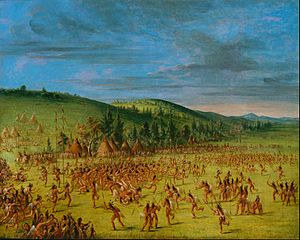
Lacrosse started with different Native American groups as early as the 1100s. By the 1600s, a version of lacrosse was well-known. Jesuit priests from France saw it being played in what is now Canada.
In the traditional Native Canadian version, teams could have anywhere from 100 to 1,000 men! The field could be several miles long. These games sometimes lasted for two or three days, from sunrise to sunset. They were played as part of ceremonies, like a symbolic battle, or to thank the Creator.
Lacrosse was very important to the tribes' community and spiritual life. Early games were deeply spiritual, like a form of combat. Players were seen as warriors, aiming to bring honor to themselves and their tribes. The game was often called "The Creator's Game" or played "for the Creator." One version was known as "baggataway."
A French Jesuit missionary named Jean de Brébeuf saw Huron tribesmen playing the game in 1637 in present-day Ontario. He called it la crosse, which means "the stick" in French. The name likely came from a French term for field hockey, le jeu de la crosse.
In 1757, James Smith described a game played by Mohawk people. They used a wooden ball about 3 inches (7.6 cm) wide. The stick they used was about 5 feet (1.5 m) long, with a net at the end big enough to hold the ball.
English-speaking people in Montreal saw the Mohawk playing in the 1830s and started playing themselves. In 1856, William George Beers, a Canadian dentist, started the Montreal Lacrosse Club. In 1860, Beers wrote down the first official rules for the game. He made games shorter and reduced the number of players to 12 per team. The first game with Beers's rules was played in 1867 at Upper Canada College.
The new sport became very popular and spread quickly. By 1900, there were many men's lacrosse clubs in Canada, the United States, England, Australia, and New Zealand. The women's game began in Scotland in 1890, started by Louisa Lumsden. The first women's club in the United States was at Bryn Mawr School in 1926.
In the United States, lacrosse was mostly played in the Mid-Atlantic states, especially New York and Maryland, during the late 1800s and early 1900s. But in the last 50 years, the sport has grown a lot and is now played in most parts of the United States. A 2016 survey by US Lacrosse showed that over 825,000 people play lacrosse nationwide. It's one of the fastest-growing team sports in high schools.
Types of Lacrosse
Field Lacrosse
Field lacrosse is the men's outdoor version of the sport. Each team has ten players: three attackmen, three midfielders, three defensemen, and one goalie. Each player uses a lacrosse stick. Attackmen and midfielders use a short stick, between 40 and 42 inches (100 and 110 cm) long. Up to four players per team can use a long stick, which is between 52 and 72 inches (130 and 180 cm) long. These are usually used by defensemen and sometimes one defensive midfielder. The goalie's stick has a wider head (up to 12 inches (30 cm)) and can be between 40 and 72 inches (100 and 180 cm) long.
The field is 110 by 60 yards (101 by 55 m). The goals are 6 by 6 ft (1.8 by 1.8 m) and are 80 yd (73 m) apart. Each goal is inside a circular "crease" that is 18 ft (5.5 m) wide. The goalie has special protection inside this crease. Offensive players or their sticks cannot enter the crease. A midfield line divides the field into offensive and defensive zones. Each team must keep four players in its defensive zone and three in its offensive zone at all times. If a team breaks this rule, it's called "offsides," and they lose possession of the ball.
A game lasts 60 minutes, split into four 15-minute periods. Play starts at the beginning of each quarter and after every goal with a face-off. In a face-off, two players put their sticks on the ground, parallel to the midfield line, with the ball between their stick heads. When the whistle blows, they try to gain control of the ball. Once a team has the ball, they try to score a goal. Because of the offsides rule, it's usually six offensive players against six defenders and a goalie.
If the ball goes out of bounds, the team that last touched it loses possession. However, if a shot goes out of bounds, possession goes to the team whose player was closest to where the ball went out. Players can substitute in and out of the game "on the fly" through a special substitution area. After penalties or goals, players can substitute freely.
Penalties are given for breaking rules. This can mean losing possession of the ball or having a player temporarily leave the field. If a player leaves, their team plays with one less player for a set time. Some penalties are "releasable," meaning the player can return if the other team scores a goal. "Non-releasable" penalties mean the player must stay off for the full time. When a team has a player in the penalty box, they are "man down," and the other team is "man up."
There are two types of fouls: technical fouls and personal fouls. Technical fouls, like offsides or holding, result in losing possession or a 30-second penalty. Personal fouls, like cross-checking or slashing, are about player safety. Cross-checking is hitting another player with the middle part of the stick. Slashing is hitting a player with the end of the stick anywhere but the gloves. These fouls result in 1-minute or longer penalties, and the player must leave the field.
Box Lacrosse
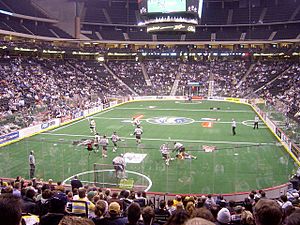
Box lacrosse is played indoors on an ice hockey rink (without ice) or an indoor soccer field. Teams have five players plus a goalie. The playing area is called a "box." This version started in Canada in the 1930s to use hockey arenas when there was no ice. It quickly became very popular in Canada.
The goals in box lacrosse are smaller than in field lacrosse, usually 4 ft (1.2 m) wide and tall. The goalie wears much more protective padding, similar to an ice hockey goalie. This includes a large chest protector, arm guards, big shin guards, and a hockey-style goalie mask.
Box lacrosse is a very fast game, partly because of the smaller space and a "shot clock." The shot clock means the attacking team must shoot at the goal within 30 seconds of getting the ball. It's also a more physical game. Since cross-checking is allowed, players wear rib pads and bigger, stronger shoulder and elbow pads. Box lacrosse players wear a hockey helmet with a special box lacrosse cage. There is no offsides rule in box lacrosse, and players substitute freely from the bench, like in hockey.
For penalties, the player goes to the penalty box, and their team plays "man-down." Most minor fouls are two minutes, while serious fouls are five minutes. In professional and junior box lacrosse, fighting doesn't always mean getting kicked out of the game, but it results in a five-minute penalty.
Box lacrosse is played at the highest level in the National Lacrosse League (NLL) and by Senior A teams in the Canadian Lacrosse Association (CLA). The NLL has some slightly different rules, like wider goals and games played in winter. NLL games have four 15-minute quarters, while CLA games have three 20-minute periods.
Women's Lacrosse
The rules for women's lacrosse are quite different from men's, especially regarding equipment and how much physical contact is allowed. Women's lacrosse rules also vary between the US and other countries, which follow World Lacrosse rules. Women's lacrosse does not allow body contact. Players only need to wear a mouth guard and eye-guard. There have been talks about requiring headgear to prevent concussions. In 2008, Florida was the first state to make headgear mandatory for women's lacrosse. Stick checking is allowed, but only in certain levels of play and with strict rules. Women's lacrosse sticks also cannot have a deep, loose net (pocket).
Women start the game with a "draw" instead of a face-off. Two players stand up, and the ball is placed between their stick heads, held horizontally at waist height. When the whistle blows, players lift their sticks into the air, trying to control where the ball goes.
The first modern women's lacrosse game was in Scotland in 1890. It was started by Louisa Lumsden, a headmistress, after she saw the game played in Quebec. The first women's lacrosse team in the United States was formed in 1926 at Bryn Mawr School in Baltimore, Maryland.
Both the number of players and the field lines are different from men's lacrosse. There are 12 players in women's lacrosse. Players must stay within certain boundaries that don't exist in men's play. These include an 8-meter (26 ft 3 in) "fan" in front of the goal, a 12-meter (39 ft 4 in) half-circle around the 8-meter fan, and a draw circle in the center of the field. The goal circle is also a bit closer to the end line. In women's lacrosse, players (besides the goalie) cannot step inside the goal circle; this is a "goal-circle violation."
The 8-meter fan in front of the goal has some rules. Defenders cannot stay inside the 8-meter fan for more than 3 seconds unless they are a stick-length away from the offensive player they are guarding. This is like the three-second rule in basketball. Breaking this rule gives the other team a free shot against the goalie. When an attacker is shooting, a defender shouldn't be in "shooting space." To be safe, a defender should lead with their lacrosse stick and be a stick-length away from the attacker.
Lacrosse Sixes
Lacrosse sixes is a version of lacrosse played outdoors with six players on each team. It has similar rules to traditional field lacrosse but with some changes and shorter game times. World Lacrosse created it in 2021 to help lacrosse become an Olympic sport. It will make its Olympic debut at the 2028 Summer Olympics in Los Angeles.
Lacrosse sixes has similar rules for men and women, but still keeps some differences, like how much contact is allowed. Here are the main rule differences compared to traditional field lacrosse:
- The field is smaller: 70 metres (230 ft) by 36 metres (118 ft).
- Face-offs only happen at the start of each quarter. After a goal, the goalie restarts play by taking the ball out of the net.
- There's a 30-second shot clock.
- Games have four 8-minute quarters.
- Teams have 12 players on their roster.
- Everyone plays both offense and defense.
- There are no long sticks.
Intercrosse
Intercrosse, also called soft stick lacrosse, is a non-contact version of lacrosse. It uses special equipment. An intercrosse stick has a head made entirely of plastic, unlike the leather or nylon nets in traditional lacrosse sticks. The ball is larger, softer, and hollow, not solid rubber like a regular lacrosse ball.
Intercrosse is a popular competitive sport for adults in Quebec, Canada, and many European countries, especially the Czech Republic. Teams usually have five players per side. The field is about 20 m (66 ft) wide and 40 m (130 ft) long. Goals for adults are the same size as in box lacrosse, 4 ft or 1.2 m tall and wide. The international group that runs intercrosse, the Fédération Internationale d'Inter-Crosse, holds a World Championship every two years.
Soft stick lacrosse is a great way to introduce young people to the sport. It can be played outdoors or indoors and is often used in physical education classes.
Lacrosse Around the World
Historically, lacrosse has been played mostly in Canada and the United States. There were also smaller but dedicated groups of players in the United Kingdom and Australia. Recently, however, lacrosse has grown a lot internationally. Teams are now being formed all over the world, especially in Europe and East Asia.
World Lacrosse
In 2008, the men's international lacrosse group (International Lacrosse Federation) and the women's group (International Federation of Women's Lacrosse Associations) joined together. They formed the Federation of International Lacrosse (FIL). In May 2019, the FIL changed its name to World Lacrosse. Currently, World Lacrosse has 62 member nations.
Tournaments
World Lacrosse organizes five world championship tournaments:
- The World Lacrosse Championship for men's field lacrosse.
- The Women's Lacrosse World Championship for women's field lacrosse.
- The World Indoor Lacrosse Championship for box lacrosse.
- The Men's Under-20 World Lacrosse Championships.
- The Women's Under-20 World Lacrosse Championships.
Each of these tournaments happens every four years.
| Tournament | Editions | First (# teams) |
Most recent (# teams) |
Most golds (# golds) |
Most silvers (# silvers) |
|---|---|---|---|---|---|
| World Lacrosse Championship | 14 | 1967 (4) | 2023 (30) | United States (11) | Canada (7) |
| Women's Lacrosse World Championship | 11 | 1982 (6) | 2022 (30) | United States (9) | Australia (4) |
| World Lacrosse Men's U20 Championship | 9 | 1988 (4) | 2022 (23) | United States (9) | Canada (7) |
| World Lacrosse Women's U20 Championship | 7 | 1995 (7) | 2019 (22) | United States (5) | Australia (4) |
| World Indoor Lacrosse Championship | 5 | 2003 (6) | 2019 (13) | Canada (5) | Haudenosaunee (5) |
The World Lacrosse Championship (WLC) started in 1968 with only four teams. Until 1990, only the United States, Canada, England, and Australia competed. As the game grew, 38 countries competed in the 2014 World Lacrosse Championship. The United States has won most of these championships, with 11 titles out of 14. Canada has won the other three.
The Women's Lacrosse World Cup (WLWC) began in 1982. The United States has won 9 of the 11 titles, and Australia has won the other two. Canada and England have always finished in the top five. The 2017 tournament in England had 25 countries competing.
The first World Indoor Lacrosse Championship (WILC) was in 2003, with six nations playing in Ontario. Canada won by beating the Iroquois Nationals 21–4. The 2007 championship, hosted by the Onondaga Nation, had 13 teams. Canada has been very strong, winning all five gold medals and never losing a game.
The Iroquois Nationals are the men's national team for the Six Nations of the Iroquois Confederacy. They were allowed to join World Lacrosse in 1987. They are the only First Nations team allowed to compete internationally in any sport. The Nationals finished fourth in the World Lacrosse Championships in 1998, 2002, and 2006, and third in 2014. Their indoor team has won silver medals in all four World Indoor Lacrosse Championships. In 2008, the Iroquois women's team, the Haudenosaunee Nationals, also joined World Lacrosse. They placed 7th in the 2013 Women's Lacrosse World Cup.
Lacrosse at the Olympics
Field lacrosse was a medal sport at the 1904 and 1908 Summer Olympics. In 1904, three teams played in St. Louis: two Canadian teams (the Winnipeg Shamrocks and a team of Mohawk people from the Iroquois Confederacy) and a US team. The Winnipeg Shamrocks won the gold medal. The 1908 games in London, England, only had two teams: Canada and Great Britain. Canada won the gold medal again, 14–10.
Lacrosse was a demonstration sport at the 1928, 1932, and 1948 Summer Olympics. This means it was shown but didn't award medals. The 1928 Olympics in Amsterdam had three teams: the United States, Canada, and Great Britain. The 1932 games in Los Angeles featured a three-game exhibition between a Canadian all-star team and the United States. The Johns Hopkins team represented the United States in both 1928 and 1932. The 1948 games had an exhibition between an "All-England" team and the Rensselaer Polytechnic Institute team from the United States. This game ended in a 5–5 tie.
There were attempts to include lacrosse as an exhibition sport at the 1996 Atlanta and 2000 Sydney Summer Olympics, but they weren't successful.
One reason lacrosse struggled to return to the Olympics was not enough international participation. To be considered, a sport used to need to be played on four continents and by at least 75 countries. Lacrosse is played on all six continents, but as of August 2019, only 63 countries played it. However, these strict rules about the number of countries have now been removed. The International Olympic Committee gave provisional status to World Lacrosse in 2018. In August 2022, lacrosse was on a shortlist of nine sports for the 2028 games. In October 2023, the LA28 Organizing Committee suggested lacrosse as one of five sports to be added. On October 16, 2023, the International Olympic Committee officially approved lacrosse for the 2028 Summer Olympics in Los Angeles!
Lacrosse Equipment
The Stick
A lacrosse stick has two main parts: the head and the shaft. The head has three parts: the scoop, the sidewall, and the pocket. The scoop is the top part that helps pick up ground balls, pass, and shoot. The sidewall is the side of the head, which affects how deep and stiff the head is. The pocket is the net, made of leather or nylon mesh, attached to the sidewall and scoop. A wider pocket makes it easier to catch balls but gives less control. A narrower pocket is harder to catch with but helps keep the ball and shoot more accurately.
Shafts are usually hollow metal and have an eight-sided shape instead of being round, which helps with grip. Most are made of aluminum, titanium, scandium, or special metal mixes. Some shafts are made from wood, plastic, carbon fiber, or fiberglass.
Stick length is regulated by rules. For men, offensive players' sticks must be 40 to 42 inches (100 to 110 cm) long. Defensemen use sticks 52 to 72 inches (130 to 180 cm) long. Goalies' sticks can be 40 to 72 inches (100 to 180 cm) long.
Women's sticks must be between 35.5–43.25 inches (90.2–109.9 cm) long overall. The head must be seven to nine inches wide. The ball must stay above the side walls when dropped in the pocket. A goalie's stick can be 35.5–48 inches (90–122 cm) long, and its head can be up to 12 inches (30 cm) wide. The goalie's stick can also have a mesh pocket.
The Ball
The lacrosse ball is made of solid rubber. For men's lacrosse, it's usually white. For women's lacrosse, it's often yellow. However, balls can also be orange or lime green, according to the rules.
Men's Field Protective Gear
Men's field lacrosse players wear several pieces of protective gear: gloves, elbow pads, shoulder pads, a helmet, a mouthguard, and cleats. The size and protection of pads can vary based on a player's position, skill, and comfort. For example, attack players often wear bigger, more protective elbow pads to guard against stick checks. Defenders might wear smaller pads because they are less likely to be checked. Goalies wear a large protective chest pad and a plastic neck guard attached to their helmet to protect their chest and throat from shots. Male goalies must also wear a protective cup.
Men's Box Protective Gear
Men's box lacrosse players wear even more protective gear than field players. This is because box lacrosse has more physical contact and allows more checking. Cross-checking from behind is allowed. Players wear larger and heavier elbow pads and stronger shoulder pads that cover more of their back. Most players also wear rib pads. Box goalies wear gear very similar to ice hockey goalies, including leg pads and large shoulder pads.
Women's Field Protective Gear
Women's field players are not required to wear much protective equipment, only eyewear and a mouthguard. The eyegear is a metal cage that covers the eyes and is held on by a strap around the head. In recent years, there have been discussions about allowing or requiring padded headgear to help prevent concussions. Women goalies wear a helmet, gloves, and a chest protector.
See also
 In Spanish: Lacrosse para niños
In Spanish: Lacrosse para niños


